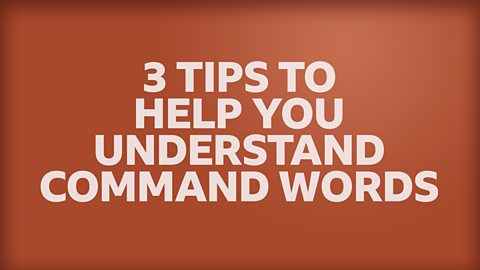When we say you might need to use P.E.E. in an exam, we aren't talking about going to the loo, we're talking about Point, Evidence, Explain. This is just one of many methods you can use to help structure an extended response to a question in your exam.
In this short video, we've asked our exam veterans to talk us through some of their favourite methods for structuring extended responses, or, if you prefer, scroll down to read some our tips for structuring your essays.
Dylan: So I have some expert tips on how to structure extended responses.
Amy: Bring it on.
Amiga: At first with extended responses I didn't know what to do, it was so new to me.
Daachi: Yeah, a teacher explained to me, P.E.E. It's like point, this is something I want to say. Evidence - here's an example, or two to back up my point. Explanation - here's where I explain and develop the evidence.
Amiga: Yeah. It makes things so much clearer. Let's have the first tip.
Daachi: Pause and plan your response.
Dylan: In extended responses you need to show not just that you remember knowledge, but also that you're being thoughtful and critical about the topic.
Amy: Before jumping into a really long answer I'd just write all of my ideas down onto a page to decide which topics I'd write about for my P.E.E paragraphs. It really helps to have the overview of what you're thinking.
Amiga: OK, next tip. Start with an introduction, a paragraph where you lay out your answer. You could simply restate the question in your own words and introduce the points that you're going to cover in the next section.
Amy: Your introduction should clearly refer to the key word from the question to show you're answering the question straight away, set out what you're focusing on and why. Don't give loads of information, keep the introduction short. Save all the analysis for the later paragraphs. #
Daachi: You're setting up your stall. You want the examiner to know where you're going.
Dylan: When I was doing my exams I would always leave the introduction till last. I would write the full essay, leave about a third of the page and then afterwards I would go back and write an introduction. That way I've got all my thoughts laid out and I know what I want to say.
Amy: Yeah. You already know what you're talking about
Dylan: Okay, what else?
Amy: Now, your main body contains your ideas which answer the question, you'll develop each idea into a paragraph. This is when your P.E.E comes in.
Amiga: With P.E.E you're just breaking your response down. Go one paragraph at a time. Take your time. It's like what's your point in this paragraph. Make your point then, give evidence and explain it.
Daachi: I'll just move through my paragraphs. Paragraph one point. Evidence. Explain. Paragraph two point. Evidence explain. Each thought you have, you're backing up with evidence and analysis. Then moving onto the next. Make your points in an order that makes sense and just work through them one by one.
Dylan: With exams like English using methods like P.E.E helped me cope better. I could really say how I felt about the text. Shakespeare was tough, but P.E.E made writing about it more manageable.
Amy: Next tip.
Dylan: Once you've written your P.E.E paragraphs, it's onto your conclusion. It's useful to restate your main points and tie them into how they may answer the question.
Amy: In the conclusion you're pulling all of your information together and summarising it. I try to make it as interesting as possible. In subjects like history you have to have a strong conclusion to get the best marks. You have to put all your arguments together and conclude in a strong impactful way.
Dylan: It's like wrapping a present and putting a bow on it. It's summarising and just wrapping everything together, all the ideas and so that the examiner clearly understands what you want to say.
Daachi: I link the conclusion to the introductionand you can sometimes end the conclusion with a rhetorical question or a powerful phrase. Something short but impacful, like, if you've been doing an English language paper on a difficult subject. You could end with how would that make you feel?
Amiga: It's your mic-drop moment.
Amy: OK, last one.
Dylan: There's not just P.E.E. There's also a P.E.A, P.E.A.C.H, PE6. Choose the right one for your subject and style.
Amy: There's P.E.E, but there's also so many other P's. I use PEA a lot. And then for our English papers we would analyse points again and again. And again. So it'd be like P.E.A.A.A. To get those in depth answers. Which one you use totally depends on the subject and how your teachers taught you.
Dylan: I used P.E.E for every subject that I had an extended response on but we also had an extra method for English called P.E.6. It's point evidence and then six questions to consider. Things like, why has the writer done this? And what is the significance of that? I didn't always do all six because there was a lot to remember.
Amiga: I also used PEACH. Point, Evidence, Analysis, Contrast and Historical context. It really helped a lot.
Daachi: Peachy.
Dylan: So plan your response. Write an introduction, do all your P.E.E. paragraphs, write a conclusion. And remember there are variations on P.E.E if they suit your subject and style.
Amy: Talking of pee, make sure you use the loo before you go into the exam.
Dylan: That's important.

How do you structure an extended response?
Knowing how to structure an extended response can help you stay on track whilst writing an essay or longer answers in an exam. Once you know a few methods and techniques to structure a response to a question, it will make it a lot easier to keep focus and get your point across in writing. So, let's get down to business and look at how to structure extended responses. We'll talk about P.E.E. a lot in this next section, but there are plenty of other methods at your disposal.
Demonstrate your thoughts In extended responses, you need to show that you're being thoughtful and critical about the topic. By structuring your response using a method like P.E.E. – Point, Evidence, Explain – you're making your point, providing evidence for why that's the case and then developing and explaining the evidence further. It's a good way to get your ideas across clearly and concisely and will help show that you fully understand the topic.
Introduce yourself Your first paragraph should be an introduction, basically setting out your stall for where you want to go with the rest of your answer. Keep your introduction short – you could just restate the question, in your own words, and explain the main points you'll be covering. You might actually prefer to go back and write the introduction after you've finished your main answer. Just make sure you leave enough time and about a third of the page blank at the top to go back to.
Pepper with P.E.E. After your introduction, you can throw P.E.E. into the mix in the main section of your answer. For each new paragraph, you should make your point, provide evidence and explain your thoughts. You should use a new paragraph for each of your points, and provide further evidence and explanation to back up your ideas. Continue like this until you are ready for your final conclusion. Think of your conclusion as pulling all your ideas together and wrapping them up with a bow – it's your chance to bring all your arguments together, make your final point and conclude in a strong, impactful way – it's your mic drop moment!
Use what suits you, or the subject There are lots of different methods for structuring extended responses, you may prefer one over the other, or some methods may suit different subjects better.
Some other examples are:
- P.E.A. – Point, Evidence, Analysis
- P.E.A.C.H. – Point, Evidence, Analysis, Contrast, Historical Context
- P.Q.D. – Point, Quote, Discuss
Remember to ask your teacher if you are unsure which method works best for the subject you are studying.

If you want some more useful exam tips and guidance, then we've got loads of amazing advice to help guide you through exam season on the pages below, what are you waiting for? Give them a tap!

If you need support
You should always tell someone about the things you’re worried about. You can tell a friend, parent, guardian, teacher, or another trusted adult. If you're struggling with your mental health, going to your GP can be a good place to start to find help. Your GP can let you know what support is available to you, suggest different types of treatment and offer regular check-ups to see how you’re doing.
If you’re in need of in-the-moment support you can contact , where you can speak to a counsellor. Their lines are open 24 hours a day, 7 days a week.
There are more links to helpful organisations on Â鶹ԼĹÄ Action Line.

3 tips to understand command words
Our exam veterans outline the importance of using command words, and show how you can use them to boss your exams.

5 tips for study success
Hold on to your hats as we're about to give you a whirlwind guide on how to study for success.

3 tips to help you understand your exam paper
Our exam veterans have some really helpful hints and tips on how to understand your exam paper.
